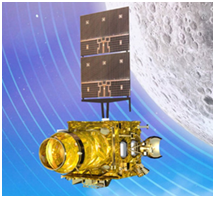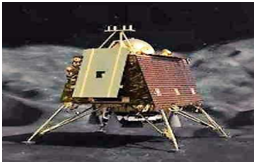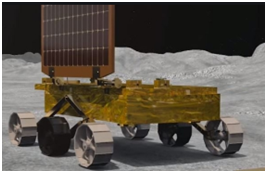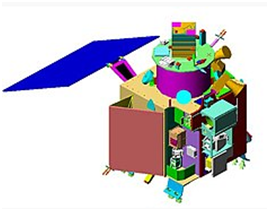Essay on Chandrayaan 2 – This article gives detailed information on the launch of Chandrayaan 1 and Chandrayaan 2. This article can help students to prepare an essay on Chandrayaan. We have tried to gather all the information related to Chandrayaan 1 and Chandrayaan 2, hope that this information will prove beneficial for you.
Read Also: Essay on Science Topics
Essay on Chandrayaan 2 in English
Chandrayaan-2 or Second Chandrayaan is India’s second lunar exploration mission after Chandrayaan-1, developed by the Indian Space Research Organization (ISRO). The expedition includes a lunar orbiter, a rover and a lander built in India.
All these have been developed by ISRO. Chandrayaan 2 was launched on July 22 from the same launch pad from where Chandrayaan 1 took off. Instead of using the previously used older PSLV rocket, the spacecraft used the Advanced Geosynchronous Satellite Launch Vehicle Mark III (GSLV Mk III).
Unlike last time, ISRO refused to carry any foreign payload due to weight restrictions. But in June 2019, it agreed to carry a small laser retroflector from NASA.
However, the orbiter will hover over the moon at a distance of 100 km and perform passive experiments as it did on Chandrayaan 1. The entire Chandrayaan 2 mission costs approximately $ 141 million.
Unlike Chandrayaan 1, this time the hopes were quite high as the spacecraft is also carried a lunar rover, orbiter, and lander. In addition, Chandrayaan 2 is the country’s first opportunity to use self-built components and design vehicles.
However, at about 1:52 am IST, the lander deviated from its intended path about 2.1 km from the landing and ground control with the spacecraft lost communication. On 8 September 2019, it was reported by ISRO that Vikram Lander has been detected from the heat painting taken by the orbiter. But Vikram Lander has not been contacted yet.
Main information of orbiter, lander, and rover

The orbiter will orbit the moon at an altitude of 100 km. In this campaign, it has been decided to send the orbiter with five payloads. Three payloads are new, while two others are improved versions of payloads which were sent on the Chandrayaan-1 orbiter.
Its weight at the time of flight was about 1400 kg. The Orbiter High Resolution Camera will give high-resolution pictures of the landing site before the lander separates from the orbiter. The mission life of the orbiter is one year and is placed in a 100 X 100 km long lunar polar orbit.

Chandrayaan 2’s lander is named after Dr. Vikram A. Sarabhai, the father of the Indian space program. It is designed to function for one lunar day, which is equivalent to about 14 Earth days. Vikram lander has the ability to communicate with IDSN as well as orbiter and rover at Bayalu near Bangalore.
But due to loss of contact with the lander, the task of the lander (Vikram) and rover (Pragyan) seems impossible.

The rover weighs 27 kg and will be powered by solar power Electric power generation capacity – 50 W. Chandrayaan 2’s rover is a 6-wheeled robotic vehicle named Pragyan, which translates to ‘knowledge’ in Sanskrit. It can travel up to 500 meters (½km) and make use of solar power for its functioning.
It can only communicate with the lander. The rover will move on the surface of the moon with wheels, collect samples of soil and rocks, chemically analyze them and send the data up to the orbiter from where it will be sent to the earth station.
However, the rover has not come out of the lander due to lack of contact with the lander and if the lander is not in contact, then the rover will not be able to do its job and the information related to the moon will not reach us.
Chandrayaan 2 features
- First Indian mission, which will attempt a soft landing on the lunar surface with domestic technology.
- First Indian mission, which will attempt to explore the lunar zone with domestic technology.
- 4th country which will make a soft landing on the lunar surface.
Current status of Chandrayaan 2
ISRO had planned to launch Chandrayaan-2 at 2:51 AM in the early hours of 15 July 2019 in Indian time, which was canceled due to some technical glitch, so its time was changed to 22 July 02:43 PM Due to this, this vehicle was successfully launched at the scheduled time.
Vikram Lander has currently lost contact with ISRO at 02:00 pm on 07 September 2019 at 2.1 km above the lunar plane. Lander is being contacted again. President of the Indian Space Research Center (ISRO), K Sivan said, “The Vikram lander landed in a normal way to an altitude of 2.1 km above the lunar surface. After this, the lander lost contact with the earth. The data is being analyzed. In September, ISRO Chairperson, Dr. K. Sivan announced that the lander was viewed with the help of a thermal image of the orbiter on the lunar surface,
Chandrayaan 1

Chandrayaan 1 was India’s first spacecraft to travel to the moon under the lunar exploration program of the Indian Space Research Organization. Although the name of this vehicle was only Chandrayaan, the name of the next vehicle in this series was Chandrayaan-2, this campaign started to be called Chandrayaan-1.
Chandrayaan 1 was launched on 22 October 2008 from the Satish Dhawan Space Center, Sriharikota and remained active till 30 October 2009. It used an indigenously developed Polar Satellite Launch Vehicle (PSLV-XL) rocket.
Chandrayaan 1 was based on an Indian meteorological satellite called Kalpasat. It took 5 days to reach the moon but it took 15 days to set up in the moon’s orbit.
The spacecraft successfully entered lunar orbit on 8 November 2008 and released its lunar impact test just six days after that. The purpose of the Chandrayaan was to find detailed maps of the lunar surface and traces of water and helium.
Its tenure was to be around 2 years, but it was closed earlier due to loss of contact with the control room. With Chandrayaan, India became the sixth country to send satellite on the moon.
This venture opened the way for sending manned aircraft to the moon and Mars.
Cruising just 100 kilometers above the lunar surface, Chandrayaan 1 took several high-resolution images of the moon’s topography. It also performed mineralogical mapping and scoured the surface for any radioactive elements.
One of the major achievements of the mission was the discovery of a large number of water molecules present in the soil of the moon. This mission cost only $ 56 million and gave us important information about the lunar surface.
Specific Areas of Study by Chandrayaan 1
- Mineral and chemical imaging of the north-polar and south-polar regions permanently under the shadow.
- Look for surface or subsurface lunar water-ice, especially at lunar poles.
Identification of chemicals in rocks. - Chemical taxonomy of the layer, imaging of internal material from the telepathy and by the South Pole Aitken Region (SPAR).
- Mapping the variation of elevation of the lunar surface.
- Observation of most stereographic coverage of the lunar surface with an X-ray spectrum greater than 10 kV and 5 m (16 ft) resolution.
- To provide new insights into understanding the origin and evolution of the Moon.
Achievement of the Century by Chandrayaan 1
The Indian Space Research Organization [ISRO] claimed that water on the moon is an exploration of India. The presence of water on the moon was detected by India’s own Moon Impact Probe [MIP] on Chandrayaan-1.
US Space Agency NASA equipment has also confirmed water on the moon. Chandrayaan-1 has made an important discovery of this century by finding the presence of water on the moon. According to ISRO, water on the moon is not present in the form of seas, waterfalls, ponds or drops, but on the surface of minerals and rocks. The presence of water on the Moon is much higher than earlier estimates.
For more details check – Wikipedia



